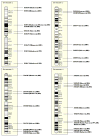Genetics of Alzheimer's disease: a centennial review
- PMID: 17659183
- PMCID: PMC2735049
- DOI: 10.1016/j.ncl.2007.03.009
Genetics of Alzheimer's disease: a centennial review
Abstract
Alzheimer's disease (AD) genetics may be one of the most prolifically published areas in medicine and biology. Three early-onset AD genes with causative mutations (APP, PSEN1, PSEN2) and one late-onset AD susceptibility gene, apolipoprotein E (APOE), exist with ample biologic, genetic, and epidemiologic data. Evidence suggests a significant genetic component underlying AD that is not explained by the known genetic risk factors. This article summarizes the evidence for the genetic component in AD and the identification of the early-onset familial AD genes and APOE, and examines the current state of knowledge about additional AD susceptibility loci and alleles. The future directions for genetic research in AD as a common and complex condition are also discussed.
Figures




References
-
- Mayeux R. Epidemiology of neurodegeneration. Annu Rev Neurosci. 2003;26:81–104. - PubMed
-
- Rice DP, Fillit HM, Max W, Knopman DS, Lloyd JR, Duttagupta S. Prevalence, costs, and treatment of Alzheimer’s disease and related dementia: a managed care perspective. Am J Manag Care. 2001 Aug;7(8):809–818. - PubMed
-
- Borenstein AR, Copenhaver CI, Mortimer JA. Early-life risk factors for Alzheimer disease. Alzheimer Dis Assoc Disord. 2006 Jan–Mar;20(1):63–72. - PubMed
-
- Whalley LJ, Dick FD, McNeill G. A life-course approach to the aetiology of late-onset dementias. Lancet Neurol. 2006 Jan;5(1):87–96. - PubMed
Publication types
MeSH terms
Substances
Grants and funding
LinkOut - more resources
Full Text Sources
Other Literature Sources
Medical
Miscellaneous

